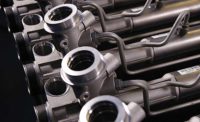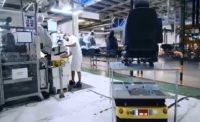Threaded Rivets Keep New Product Made in the USA

Threaded rivets are similar to barrel nuts, in that the female portion has a shoulder that stops the male rivet head to create a fastener with a definitive length. Photo courtesy National Rivet & Manufacturing Co.

At Dee Zee’s factory in Des Moines, IA, a worker installs threaded rivets in Invis-A-Rack components. Photo courtesy Dee Zee Inc.

Loctite Dri-Loc threadlocker is applied to the male portion of the threaded rivets before they are shipped to Dee Zee. Photo courtesy Dee Zee Inc.

The Invis-A-Rack is a folding cargo rack for pickup trucks. It folds up and locks in place when needed to carry a ladder or canoe. When it’s not needed, it collapses into compartments on each side of the bed. Photo courtesy Dee Zee Inc.

Threaded rivets securely fasten an Invis-A-Rack joint without squeezing it so tightly that it won’t pivot. Photo courtesy Dee Zee Inc.





Donny McCall fought sharks and won.
A guest on season three of ABC’s business-themed show “Shark Tank,” McCall respectfully disagreed with the venture capitalist “sharks.” They said he needed to outsource manufacturing of his Invis-A-Rack folding cargo rack to China to do what’s best for the business and create better margins. But McCall had other ideas. His insistence on made-in-America quality and supporting American jobs meant that the sharks declined to financially support efforts to take his business to the next level.
Fortunately, the folks at Dee Zee Inc., a manufacturer of truck accessories based in Des Moines, IA, got word of Invis-A-Rack as a result of “Shark Tank.” Since more than 95 percent of the 2,800 products Dee Zee sells are also made in America, the two parties shared mutual values. McCall agreed to give Dee Zee exclusive manufacturing rights to his product for a period of time, and the racks are now among the company’s standard offerings.
The arrangement has been an unqualified success. After just three months, Dee Zee sold more Invis-A-Racks than McCall had sold in the previous three years.
Another American manufacturer also played a pivotal role—literally—in bringing the Invis-A-Rack to market. National Rivet & Manufacturing Co., a fourth generation family-owned business in Waupun, WI, worked with McCall to design and supply the threaded aluminum rivets that enable the rack’s extruded aluminum channels to fold in and out of their bed rail casings. In addition to their structural function, the threaded rivets have greatly simplified manufacturing and improved customer service and warranty repair issues.
A Vision from God
“I’m not a mechanical engineer,” says McCall. In fact, he’s an independent home remodeler and founder of McCall’s Construction in Sparta, NC.
“I wasn’t trying to invent anything,” he recalls. “I was driving down the Blue Ridge Parkway, going from one job site to another. It wasn’t even a day when I needed a rack on my truck, but in about two seconds, this vision came, and I believe that it came from God. I had two guys in my truck, and I said to them, ‘Have you ever seen a rack system that folds up and locks into place so you can carry a ladder, then easily collapses when you don’t?’ Well, of course they hadn’t, because it didn’t exist—yet.”
Like many contractors, McCall’s work truck was also his personal truck. He didn’t like the look of a permanent rack. He didn’t like how it could prevent loading larger items, such as appliances or furniture, into the truck bed, and he didn’t like how it increased drag and reduced fuel economy. Yet at the same time, he wanted a rack to carry the occasional ladder, lumber or canoe.
“I compare the Invis-A-Rack to four-wheel drive: You don’t need it all the time, but when you need it, it’s invaluable,” he says.
McCall’s vision started an 18-month quest to prototype the first Invis-A-Rack. Along the way, he learned more about aluminum extrusions, powder coatings, plastics and dies than he thought possible. Fortunately, he didn’t have to learn too much about threaded rivets on his own. About a year earlier, McCall had worked on the home of Wade Stickels of Southeast Engineered Sales Inc., National Rivet’s area sales representative. When McCall was ready to move into the manufacturing phase, he contacted Stickels.
“By the time Donny called me, he was so far down the design path that all the lengths he needed were special sizes,” says Stickels. “With National Rivet, custom-length fasteners aren’t a problem. In fact, they’re pretty standard, because rivet size is a design afterthought 90 percent of the time. Fortunately, National Rivet is the go-to source for rivets you won’t find in a catalog, and they’re also willing to work with customers on minimum order quantities.”
The Invis-A-Rack has the following pivot points and fastener size requirements:
The main vertical arm attached to the lower horizontal brace (sitting on the bed rail) uses a 3/8-inch x 3.062-inch threaded rivet.
The horizontal arm (going across the truck) that attaches to the top of the vertical arm uses a 3/8-inch x 1.41-inch threaded rivet.
The diagonal brace that attaches to the vertical arm and lower horizontal brace uses a 1/4-inch x 2.04-inch threaded rivet.
The diagonal brace that attaches to the vertical arm and top horizontal arm uses a 1/4-inch x 1-inch threaded rivet.
There are also two dowel pins to permit portions of the lower brace and upper brace to slide, and National Rivet also supplied these.
The Rationale for Rivets
McCall knew from the start he wanted a modular rack with pivot points. “With modularity, if the customer damages one portion of the rack, we can replace just that portion instead of trashing the entire thing,” he says. “Compare that to a welded rack. Any damage either ruins the whole rack for the customer or costs us a lot to fix as a warranty repair.”
McCall looked at using a conventional rivet and bushing on either side of the rail, but that, too, had manufacturing and repair limitations. Wanting a fastener that “a guy could just press in and turn with a screwdriver,” McCall started experimenting with sex bolts. Also known as Chicago bolts and barrel nuts, they consist of a threaded male bolt that fits inside a threaded female connector.
Threaded rivets are similar in that the female portion has a shoulder that stops the male rivet head to create a fastener with a definitive length. As a result, they can securely fasten an Invis-A-Rack joint without squeezing it so tightly that it prevents pivoting or scrapes off the powder coating. Further, if one C channel is a little too wide, the threaded rivet pulls it closed to the correct dimensions.
“Wade Stickels introduced me to threaded rivets,” says McCall. “National Rivet put a Phillips head on both components. That would enable anyone with two screwdrivers to install or replace the rivets, fulfilling the manufacturing and repair issues I envisioned.”
Well, almost.
Making the Grade
McCall was familiar with 6061 aircraft-grade aluminum from his days in the Navy. However, he originally thought of anodizing the rivets, and 6061 doesn’t anodize well. As a result, the initial order of threaded rivets used 5056 aluminum.
“Unfortunately, the manual assembly operation at Dee Zee stripped the heads of the rivets fairly often, so they’d have to drill them back out. That wasted time and materials,” says McCall, who remains connected to Dee Zee as a consultant.
To solve the problem, McCall worked directly with Bart Ludjack, a sales engineer at National Rivet, who recommended using 2117 T4 aluminum. This grade has decent machinability, and National Rivet hardens and ages it in-house to control quality. The 2117 T4 grade has a tensile strength of 43,000 psi and a yield strength of 24,000 psi, which met the Invis-A-Rack’s design requirement of supporting 500 pounds.
“The 2117 T4 grade solved the problem of stripping during assembly,” says McCall.
To solve the problem that all threaded connections have—backing out under vibration—Loctite Dri-Loc threadlocker is applied to the male portion of the threaded rivets before they are shipped to Dee Zee.
American Success
In the time that McCall has been selling Invis-A-Rack, he has only had two returns. The first was because the customer bought the wrong size for his truck. The other customer initially said that he was only carrying a couple of ladders when the rack broke. McCall requested that the customer send in the damaged part.
“After looking at the structural damage, I deduced that he must have had a heavy load of tools in the bed of his truck and, after removing them, the truck rode a little higher. That was enough to knock the back portion of the rack down as he drove out of the garage,” says McCall.
The customer not only gladly purchased the replacement components, he ended up being a repeat customer…because he hit the top of his garage again.
“I tell that story because it fulfills my vision of creating a modular folding rack that the customer can install and repair himself,” says McCall.
Thus far, the Invis-A-Rack has been a success from every angle. Dee Zee’s purchasing volumes enable the company to make suitable margins, while its online sales model provides the necessary volume. Most importantly, McCall has become a face for American ingenuity and American manufacturing.
“There are companies that have been doing this far longer, but they’re not getting the public visibility that I have right now,” McCall says humbly. “I’m glad to carry the banner, because it’s exactly what I believe in. I want to do what I can as one person. If that inspires more people, pretty soon we could be making a lot more products here in America.”
Looking for a reprint of this article?
From high-res PDFs to custom plaques, order your copy today!










